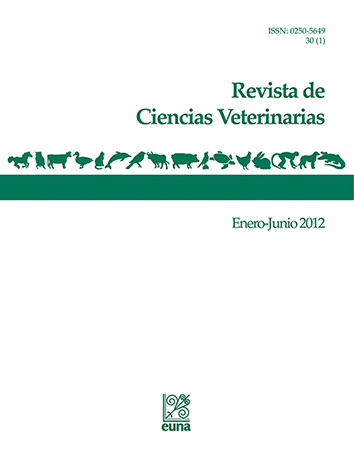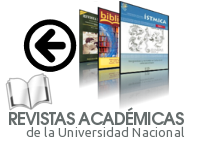Tetraiodothyronine, triiodothyronine and cortisol serum levels in Costa Rican dogs using an immunoassay analyzer
Keywords:
canines, hormones, reference interval, AIA-360®Abstract
Hormonal reference intervals vary according the measurement method used and the geochemical environment where populations develop. Consequently, each lab must have its own reference intervals in order to interpret results properly. This paper was aimed at establishing a reference interval for total T4 (TT4), free T4 (FT4), total T3 (TT3) and cortisol in Costa Rican dogs, using the Tosoh Bioscience’s AIA-360® automatic analyzer. Blood serum from 122 randomly selected clinically healthy canines was used to determine reference intervals. Additionally, TT4, FT4 and TT3 were measured in 123 canines with suspected symptoms of hypothyroidism, and a low dose dexamethasone suppression test was performed in 12 canines with suspicious signs of hyperadrenocorticism. Samples were processed in the AIA-360® equipment after calibration curves were performed following manufacturer’s instructions. The reference interval was estimated based on the 3rd. and 97th. percentiles of healthy canines values: TT4 11.58 nmol/L – 50.19 nmol/L; FT4 6.18 pmol/L – 41.18 pmol/L; TT3 0.69 nmol/L – 1.64 nmol/L; cortisol 17.38 nmol/L – 174.64 nmol/L. FT4 concentration was statistically lower (p<0.05) in canines with suspected symptoms of hypothyroidism. Four of the canines with suspicious signs of hyperadrenocorticism did not suppress, while 7 suppressed at 4 hours after dexamethasone, but rebounded at 8 hours. Currently, a reference interval for TT4, FT4, TT3, and cortisol is available for Costa Rican canines using the AIA-360® analyzer.
References
ASVCP, American Society for Veterinary Clinical Pathology. 2013. ASVCP guidelines: quality assurance for point-of-care testing in veterinary medicine. 42:405–23. doi:10.1111/vcp.12099.
ASVCP, American Society for Veterinary Clinical Pathology. 2005. Guideline for the Determination of Reference Intervals in Veterinary Species and Other Related Topics. 1–33.
Cornell-University. 2012. Animal Health Diagnostic Center- New York State Veterinary Diagnostic Laboratory.
Daminet, S., & D.C. Ferguson. 2003. Influence of drugs on thyroid function in dogs. J. Vet. Intern. Med. 17:463–72.
Di Rienzo, J.A., F. Casanove, M.G. Balzarini, L. Gonzalez, M. Tablada, & C.W. Robledo. 2014. InfoStat.
Dixon, R. 2012. Hipotiroidismo canino. In Manual de Endocrinología en pequeños animales. C. Mooney and M. Peterson, editors. Ediciones S, Barcelona, España. 111–137.
Dosoo, D.K., K. Kayan, D. Adu-Gyasi, E. Kwara, J. Ocran, K. Osei-Kwakye, E. Mahama, S. Amenga-Etego, P. Bilson, K.P. Asante, K. a Koram, & S. Owusu-Agyei. 2012. Haematological and biochemical reference values for healthy adults in the middle belt of Ghana. PLoS One. 7:e36308.
Feldman, E.C., & R.W. Nelson. 2007. Endocrinología y reproducción canina y felina. 3rd ed. Inter-Médica.
Fialkovičová, M., S. Mardzinová, M. Benková, J. Mojžišová, M. Gaálová, & E. Sesztáková. 2012. Seasonal influence on the thyroid gland in healthy dogs of various breeds in different weights. Acta Vet. Brno. 81:183–188.
Ganswindt, A., J.L. Brown, E.W. Freeman, A.J. Kouba, L.M. Penfold, R.M. Santymire, M.M. Vick, N. Wielebnowski, E.L. Willis, & M.R. Milnes. 2012. International Society for Wildlife Endocrinology: the future of endocrine measures for reproductive science, animal welfare and conservation biology. Biol. Lett. doi:10.1098/rsbl.2011.1181.
Gaughan, K., & D. Bruyette. 2001. Thyroid function testing in Greyhounds. Am J Vet Res. 62:1130–3.
Graham, P. 2009. Canine hypothyroidism: diagnosis and therapy. In Pract. 31:77–82.
Herrtage, M.E. 2012. Hiperadrenocorticismo canino. In Manual de Endocrinología en pequeños animales. C.T. Mooney and M.E. Peterson, editors. Ediciones S, Barcelona, España. 217–247.
Higgs, P., M. Costa, A. Freke, & K. Papasouliotis. 2014. Measurement of thyroxine and cortisol in canine and feline blood samples using two immunoassay analysers. J. Small Anim. Pract. Jan 20.:1–7. doi:10.1111/jsap.12181.
IBM Company. 2010. IBM SPSS Statistics.
Joshi, S.R. 2011. Laboratory evaluation of thyroid function. J. Assoc. Physicians India. 59 Suppl:14–20.
Kemppainen, R.J., & C.A. Zerbe. 1989. Common Endocrine Diagnostic Tests: Normal Values and Interpretation. In Current Veterinary Therapy X: Small Animal Practice. R.W. Kirk, editor. W.B. Saunders., Philadelphia. 961–968.
Lousiana-State-University. 2011. Canine Index. Canine Breed. Manag.
Machida, T., E. Uchida, K. Matsuda, K. Hirayama, K. Yoshii, M. Takiguchi, & H. Taniyama. 2008. Aldosteron, Corticosterone and Cortisol Secreting Adrenocortical Carcinoma in a Dog: Case Report. J. Vet. Med. Sci. 70:317–320.
Nachreiner, R., & K. Refsal. 2012. Toma, almacenaje y transporte de muestras. In Manual de Endocrinología en pequeños animales. C. Mooney and M. Peterson, editores. Ediciones S, Barcelona, España. 1–6.
Paradis, M., F. Sauvé, J. Charest, K.R. Refsal, M. Moreau, & J. Dupuis. 2003. Effects of moderate to severe osteoarthritis on canine thyroid function. Can. Vet. J. 44:407–12.
Pessina, P., A. Fernández-Foren, E. Cueto, L. Delucchi, V. Castillo, & A. Meikle. 2009. Cortisol secretion after adrenocorticotrophin (ACTH) and dexamethasone tests in healthy female and male dogs. Acta Vet. Scand. 51:33. doi:10.1186/1751-0147-51-33.
Ramírez-Benavides, G., & H. Osorio. 2009. Niveles séricos de tretrayodotironina libre (T4L), mediante el método de electroquimiolumiscencia en caninos. Rev. Científica FCV-LUZ. XIX:238–241.
Ramos, G.M.M., & J.L. Carlos-Raboca. 2012. The Degrees of Agreement Between Chemiluminescence Enzyme Immunoassay Versus Immunoradiometric Assay and Radioimmunoassay Among Adult Filipino Patients with Different States of Thyroid Function. Philipp. J. Intern. Med. 50:5–8.
Ramos-Casals, M., M. García-Carrasco, M.P. Brito, a López-Soto, & J. Font. 2003. Autoimmunity and geriatrics: clinical significance of autoimmune manifestations in the elderly. Lupus. 12:341–355.
Van Casteren, J.I., W.G. Schoonen, & H.J. Kloosterboer. 2000. Development of time-resolved immunofluorometric assays for rat follicle-stimulating hormone and luteinizing hormone and application on sera of cycling rats. Biol. Reprod. 62:886–94.
Vassault, A. 2012. Quality control tools. In Quality of Management & Quality of Anlysis.International Federation of Clinical Chemistry and Laboratory Medicine, editor. 56–83.
Vermeulen, M.A.E. 2009. Ovarian Color-Doppler Ultrasonography to Predict Ovulation in the Bitch. Louisiana State University.
Waite, K. V, G.F. Maberly, & C.J. Eastman. 1987. Storage conditions and stability of thyrotropin and thyroid hormones on filter paper. Clin. Chem. 33:853–5.
Walton, R.M. 2012. Subject-based reference values: biological variation, individuality, and reference change values. Vet. Clin. Pathol. 41:175–81.
Wang, X., H. Chen, J.-M. Lin, & X. Ying. 2007. Development of a highly sensitive and selective microplate chemiluminescence enzyme immunoassay for the determination of free thyroxine in human serum. Int. J. Biol. Sci. 3:274–80.
Wheeler, M.J. 2013. A Short History of Hormone Meassurement. Methods Mol. Biol. 1065:1–6.
Downloads
Published
How to Cite
Issue
Section
License
Licensing of articles
All articles will be published under a license:

Licencia Creative Commons Atribución-NoComercial-SinDerivadas 3.0 Costa Rica.
Access to this journal is free of charge, only the article and the journal must be cited in full.
Intellectual property rights belong to the author. Once the article has been accepted for publication, the author assigns the reproduction rights to the Journal.
Ciencias Veterinarias Journal authorizes the printing of articles and photocopies for personal use. Also, the use for educational purposes is encouraged. Especially: institutions may create links to specific articles found in the journal's server in order to make up course packages, seminars or as instructional material.
The author may place a copy of the final version on his or her server, although it is recommended that a link be maintained to the journal's server where the original article is located.
Intellectual property violations are the responsibility of the author. The company or institution that provides access to the contents, either because it acts only as a transmitter of information (for example, Internet access providers) or because it offers public server services, is not responsible.







